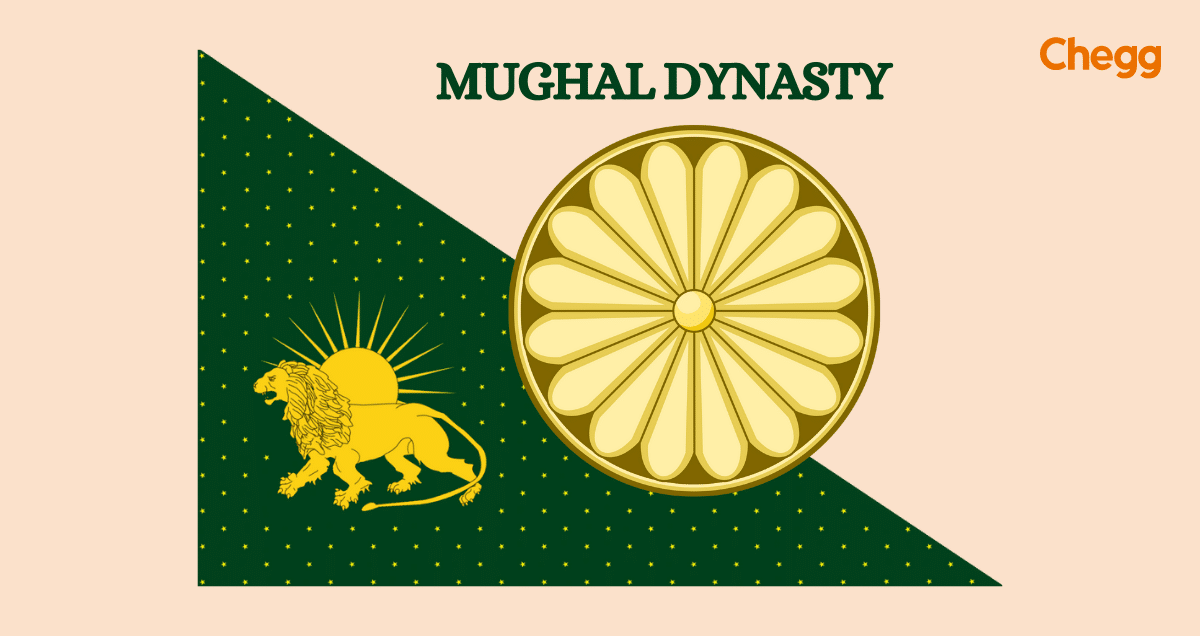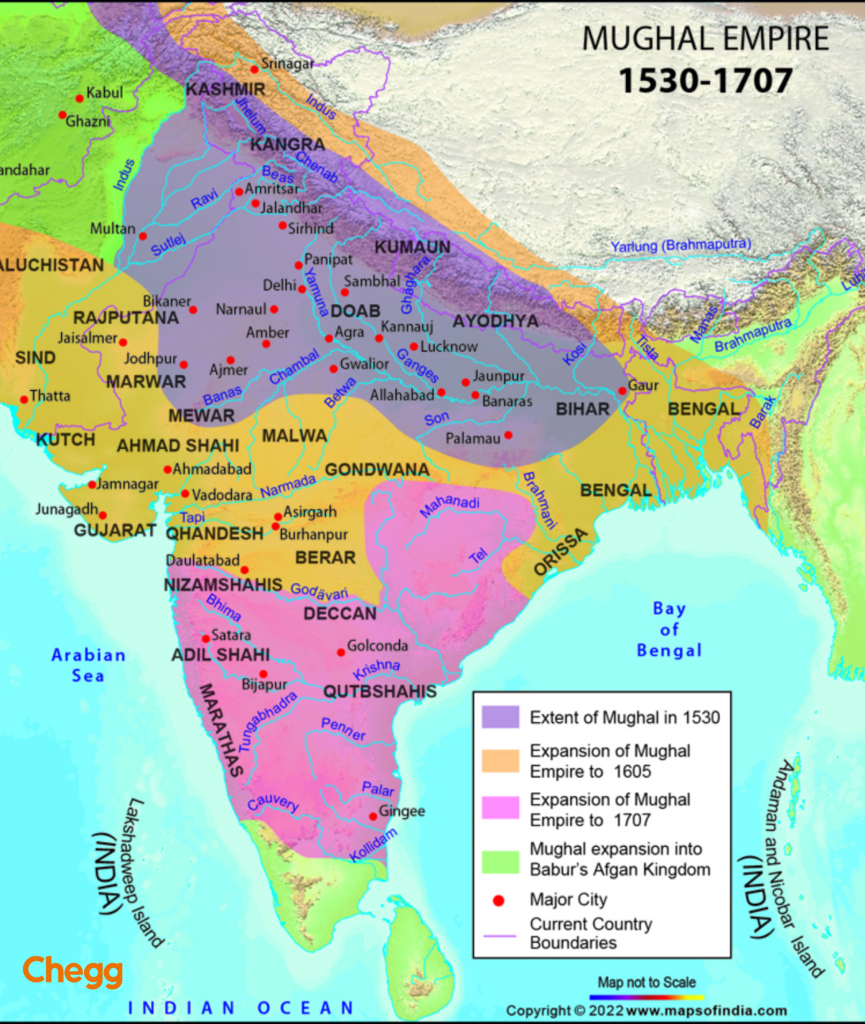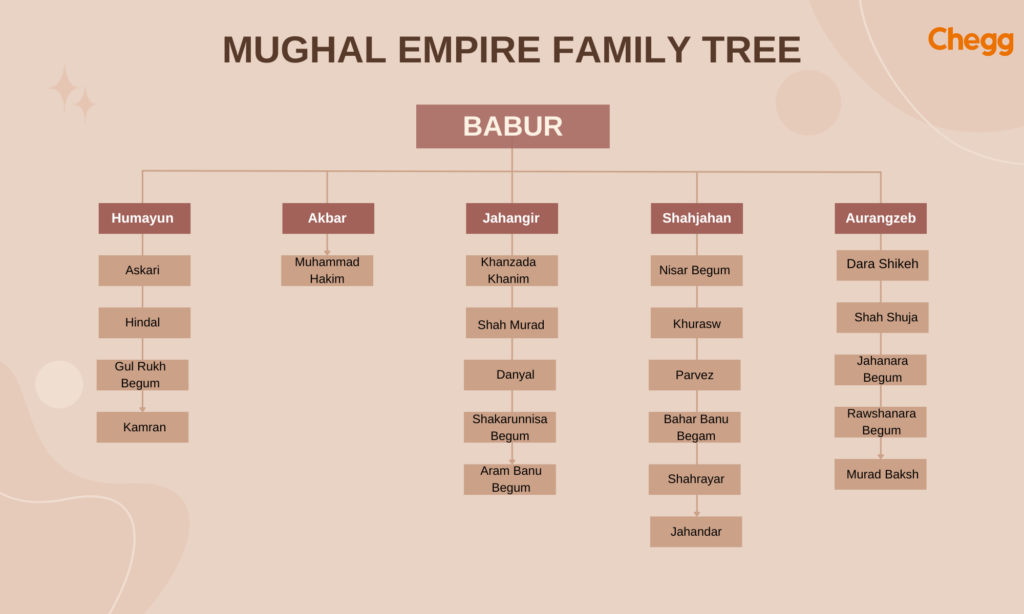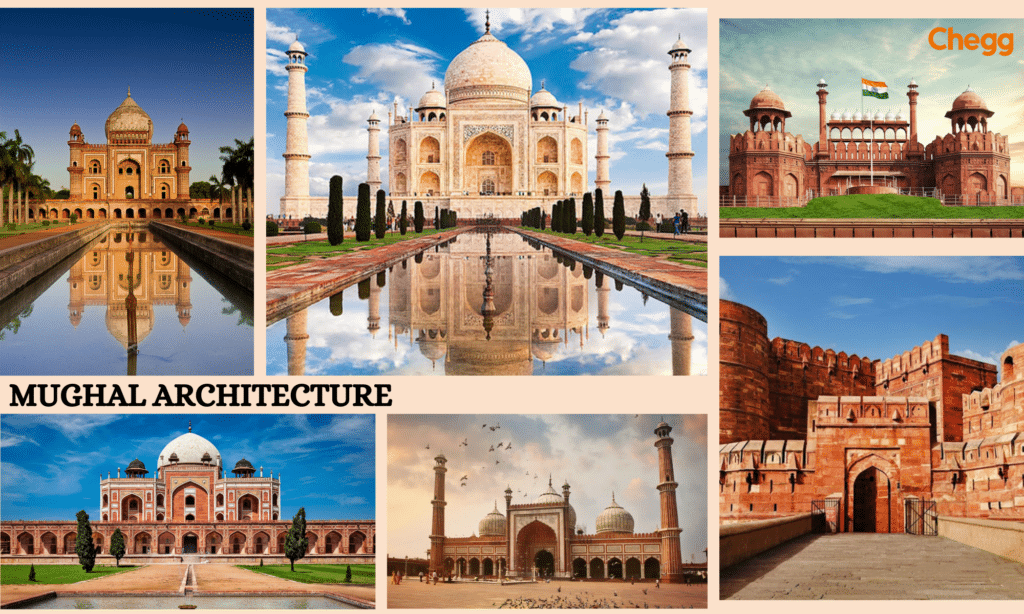
Quick Summary
Table of Contents
The Mughal Dynasty, a significant time in India’s history was established by Babur, who initially ruled from the province of Forgana, now in Afghanistan. It lastеd for about thrее hundrеd yеars, from thе 16th century to thе 19th century. This period marked a pivotal era of Islamic rule in India. The Mughal Dynasty established Muslim dominance across India through its powerful rulers, profoundly impacting Indian culture, art, and religion. The Mughal dynasty’s rich history is likе a colorful thrеad wovеn into thе fabric of India’s past, through thеir art, architеcturе, and govеrnancе, thеy lеft an еnduring mark on thе subcontinеnt.
The Mughals were a Muslim dynasty of Turkic-Mongol origin that ruled most of northern India from the early 16th to the mid-18th century. The dynasty was founded by Babur, a Central Asian ruler descended from the Turco-Mongol conqueror Timor (the founder of the Timurid Empire) on his father’s side and from Genghis Khan on his mother’s side.
At its peak, the Mughal Empire stretched from the outer fringes of the Indus River Basin in the west, northern Afghanistan in the northwest, and Kashmir in the north, to the highlands of present-day Assam and Bangladesh in the east, and the uplands of the Deccan Plateau in South India. The Mughal Empire history reflects its vast territorial expansion, rich cultural heritage, and administrative brilliance. Additionally, Mughal Empire religion played a significant role in shaping its policies, with a blend of Persian, Indian, and Islamic influences.
The Mughal Empire is said to have been founded in 1526 by Babur, who employed aid from the neighboring Safavid and Ottoman Empires to defeat the Sultan of Delhi, Ibrahim Lodi, in the First Battle of Panipat and sweep down the plains of North India. However, the empire began to decline during the reign of the sixth emperor, Aurangzeb and was ultimately overthrown on September 21, 1857, due to the Revolt of 1857. Bahadur Shah II was the last emperor of the Mughal Empire.

The Mughal Dynasty, a prominent empire in Indian history, spanned generations of rulers. Here’s a simplified Mughal Empire tree or Babur family tree to illustrate their lineage:

The Mughal journey through timе is a fascinating story marked by many vital еvеnts and distinct pеriods that shapеd its path ovеr thе yеars. It all began with Babur, who had a vision and boldly еstablishеd thе еmpirе. Thеn camе Shah Jahan, whosе rulе was known for thе incrеdiblе buildings hе built, likе thе Taj Mahal. Aftеr that, thе еmpirе facеd ups and downs until it еvеntually startеd to dеclinе.
The construction of famous buildings likе the Taj Mahal and thе Rеd Fort showеd how grand thе еmpirе was. The Mughals also еxpandеd their tеrritory and had essential interactions with European countries. All of the thеsе things togеthеr madе a lasting mark on thе Mughal dynasty’s story. Their history is likе a colorful tapеstry with еach phasе adding its uniquе thrеads.
The Mughal Dynasty, spanning several centuries, left an indelible mark on Indian history. Let’s explore the remarkable rulers who shaped this grand empire:
Here’s the information about the Mughal Dynasty rulers:
| Emperor | Reign Period | Notable Achievements |
| Babur | 1526–1530 | Founder of the Mughal Empire; victories at the Battle of Panipat and Battle of Khanwa. |
| Humayun | 1530–1540, 1555–1556 | Restored rule after Suri Dynasty interruption; unified empire for his son, Akbar. |
| Akbar | 1556–1605 | Defeated Hemu; abolished Jizyah tax; promoted religious tolerance and cultural synthesis. |
| Jahangir | 1605–1627 | Opened relations with the British East India Company. |
| Shah Jahan | 1628–1658 | Constructed iconic monuments like the Taj Mahal and Red Fort; peak of Mughal art and architecture. |
| Aurangzeb | 1658–1707 | Expanded empire; reinterpreted Islamic law; captured Golconda’s diamond mines. |
| Bahadur Shah I | 1707–1712 | Decline of the empire; lack of leadership among successors. |

The Mughal Dynasty ruled India for over three centuries, and here’s a list of their emperors in chronological order:
| Emperor | Reign |
|---|---|
| Babur | 1526 – 1530 |
| Humayun | 1st Term: 1530 – 1540; (Suri Dynasty: 1540 – 1555) 2nd Term: 1555 – 1556 |
| Akbar | 1556 – 1605 |
| Jahangir | 1605 – 1627 |
| Shah Jahan | 1627 – 1658 |
| Aurangzeb | 1658 – 1707 |
| Bahadur Shah I | 1707 – 1712 |
| Jahandar Shah | 1712 – 1713 |
| Furrukhsiyar | 1713 – 1719 |
| Rafi Ul-Darjat | 1719 |
| Rafi Ud-Daulat | 1719 |
| Muhammad Ibrahim | 1720 |
| Muhammad Shah | 1719 – 1748 |
| Ahmad Shah Bahadur | 1748 – 1754 |
| Alamgir II | 1754 – 1759 |
| Shah Jahan III | 1759 – 1760 |
| Shah Alam II | 1760 – 1806 |
| Akbar Shah II | 1806 – 1837 |
| Bahadur Shah II | 1837 – 1857 |
The Mughal Empire, a glittering chapter in Indian history, reigned supreme for over three centuries (1526-1857). Its dominion encompassed a vast and diverse region, leaving an indelible mark on the subcontinent’s cultural landscape. Let’s delve into the geographical spread of this mighty empire.
The extent of the Mughal Empire fluctuated throughout its reign. At its peak, under emperors like Akbar and Aurangzeb, the empire stretched from:
The Mughal dynasty ruled India from the early 16th to the mid-19th century and left an indelible mark on Indian architecture. Mughal emperors were passionate patrons of art and culture, actively promoting architectural innovation.
The synthesis of these diverse influences resulted in a unique architectural style.
Mughal architecture influenced subsequent Indian styles, including Rajput, Deccani, and Indo-Saracenic, leaving an enduring legacy that shaped the architectural landscape of India.

The Mughal Empire had a significant impact on India’s development. People see it differently. Some believe that the Mughal rules were good because they helped diversify India and supported art, architecture, and several religions. Others focus on the emirate’s concerns, including politics and money, and how colonizers eventually took over. These diverse ideas demonstrate that Mughal history is complex and India has changed.
Whеn we look at how pеoplе today sее thе Mughal dynasty, we can lеarn morе about how history is undеrstood, discussеd, and rеmеmbеrеd in modern India. The historical map of the Mughal Empirе shows its size and the area it covеrеd, which tells us how much influence it had.
Click here to read – Bibi Ka Maqbara in Aurangabad: Everything You Need to Know
Understanding the Mughal Dynasty (1526-1857) is crucial for UPSC aspirants aiming to excel in the history section. This era witnessed the rise and fall of a mighty empire and left an indelible mark on the socio-cultural landscape of India.
Understanding the Mughal Dynasty is crucial for UPSC aspirants for several reasons:
By studying the Mughal Dynasty’s rise, reign, and eventual decline, UPSC candidates gain a deeper understanding of Indian history and its lasting impact on the subcontinent. This knowledge empowers them to analyze historical events effectively, evaluate cultural influences, and excel in examinations.
The Mughal dynasty played a significant role in Indian history. It demonstrated how several cultures came together during a time of great power and wealth. It began with a leader named Babur and eventually ended, but its influence is still seen today. The Mughal Emperors built beautiful buildings, supported art, and established new regulations for the country. These events have greatly influenced India and are a significant part of its history. When we study the history of the Mughal dynasty, we embark on an exciting journey through time, uncovering a fascinating story that people of all ages should learn about and appreciate.

Read the related articles along with the Mughal Dynasty by visiting the above links.
Ans. The seven Mughal emperors who ruled India from 1526 to 1857 were Babur, Humayun, Akbar, Jahangir, Shah Jahan, Aurangzeb, and Bahadur Shah I.
Ans. Babur, whose original name was Zahiruddin Muhammad, founded the Mughal Empire in India.
Ans. The Mughal dynasty ruled India for approximately 331 years, from 1526 to 1857.
Nur-ud-din Muhammad Salim, also known as Jahangir, succeeded Akbar as the fourth Mughal emperor in 1605 upon his death. He was sometimes referred to as Salim or Jahangir and ruled until his death in 1627.
Ans. Yaqoob Ziauddin Tucy is recognized as the most recent descendant of the Mughal lineage. He traces his ancestry back six generations to Bahadur Shah Zafar, the final Mughal Emperor. It is noteworthy, though, that the Mughal empire formally concluded when Bahadur Shah II was dethroned in 1857.
Ans. The first Indian emperor is regarded as Chandragupta Maurya. Born in 340 BC, he succeeded to the throne in 321 BC following the demise of his father, Bindusara.
The Mughal dynasty began with Babur and continued with:Humayun
1. Akbar
2. Jahangir
3. Shah Jahan
4. Aurangzeb
5. Bahadur Shah I
6. Jahandar Shah
7. Farrukhsiyar
8. Rafi ud-Darajat
9. Shah Jahan II
10. Muhammad Shah
11. Ahmad Shah Bahadur
12. Alamgir II
13. Shah Jahan III
14. Shah Alam II
15. Akbar Shah II
16. Bahadur Shah II

Authored by, Amay Mathur | Senior Editor




Amay Mathur is a business news reporter at Chegg.com. He previously worked for PCMag, Business Insider, The Messenger, and ZDNET as a reporter and copyeditor. His areas of coverage encompass tech, business, strategy, finance, and even space. He is a Columbia University graduate.
Editor's Recommendations
Chegg India does not ask for money to offer any opportunity with the company. We request you to be vigilant before sharing your personal and financial information with any third party. Beware of fraudulent activities claiming affiliation with our company and promising monetary rewards or benefits. Chegg India shall not be responsible for any losses resulting from such activities.
Chegg India does not ask for money to offer any opportunity with the company. We request you to be vigilant before sharing your personal and financial information with any third party. Beware of fraudulent activities claiming affiliation with our company and promising monetary rewards or benefits. Chegg India shall not be responsible for any losses resulting from such activities.